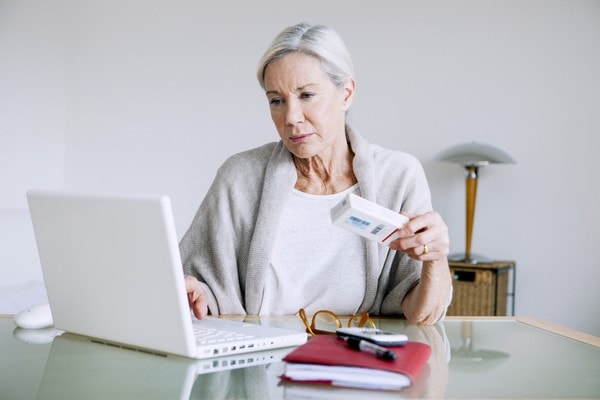An article on Christine Thomas appeared in COPING May 10, 2013, access it here.
We thought it would be great to get caught up with Christine.
Background: Christine Thomas was only 42 when, bending to lift her newborn daughter, she fractured her spine. Diagnosed with five vertebral fractures as a result of unsuspected osteoporosis, she had no idea of the painful and transformative road she would have to travel to build stronger bones and reclaim her life.
What have you been up to since your diagnosis of osteoporosis and spinal fractures?
Since 2002, I have researched the disease extensively, launched my website and book Unbreakable, and now blog and tweet! I have been a volunteer in various roles with Osteoporosis Canada, but I have to say the most rewarding experiences come from meeting people at my seminars. Recently I attended the 100th birthday celebration of Pat Giff, whom I met at one of my speaking engagements and who was featured in the December 14, 2016 issue of COPING. She was so grateful for the knowledge and resources she gained from the event and I was in awe of meeting such an incredible woman who, despite having multiple fractures from osteoporosis, was living well with the disease at 100! In this crazy, busy world we live in, many of us do not take time for seniors; yet, we have so much to learn from them. Engaging with Pat is incredible. She is witty, vibrant and funny. There is something very humbling listening to her stories and rich wisdom.
What do you consider most challenging living with osteoporosis?
Pain! The spine, the body’s information superhighway, is our body’s central structure and tower of strength. Spinal fractures alter that tower and even after they heal, can cause intermittent chronic pain. Chronic pain can rob you blind. It can take away your livelihood, your friends, your activities and big chunks of your personality. In our household, when Momma is happy, everyone’s happy. When I am struggling, the whole family feels it!
I have learned so much about pain and how it is so important to be open to ways to manage my pain that complement medication. Massage therapy, meditation and breathing exercises are really helpful for me. They relax and calm those nasty tight muscles. They may not eliminate my pain but they sure help reduce it and improve my quality of life.
We asked Christine’s husband, Gerry, this question: How has your family adapted?
- At one time, we had to be careful about everything. It seemed that every normal activity had an inherent risk. Now, we no longer notice how much our lives have changed. What we do just feels normal now – it is difficult to identify specific things that we do to adapt but here are a few examples that come to mind:
- We always check winter weather to determine how (not if) we will deal with its worst conditions. We make sure there is always a steady hand to lend support in slippery conditions. Even on normal days, we drive a little slower than most on side roads to minimize the effects of the city’s many speed bumps, which can be jarring for Christine’s spine.
- We take vacations like everybody else, and look forward to them like any other family. We are just careful to choose accommodations that provide maximum comfort for Christine. For example, she loves to swim in the ocean but she needs a gentle sea flow and a flat beach for easy entry, while our daughter Chanel loves to tackle the big waves and surf, so we alternate among beaches to accommodate everyone!
- Our home is a large two-bedroom condo, which is common for a family in New York or Vancouver but unique for a family in Ottawa. It is in a fabulous neighborhood that has lots of parks and the building offers so much — a gym, pool and indoor parking, so no snow shovelling required! As fitness is a priority for Christine, she can roll out of bed and be in the gym in minutes. At first we were hesitant to make the move to the condo but realized it was best for all of us – especially Christine. We realized that kids need love and support. Our daughter can get that just as well in a condo as in a house!
Back to Christine: What has your daughter learned about osteoporosis?
Our daughter, Chanel, learned from a very young age about the building blocks to take care of her bones – calcium, vitamin D and exercise. The good news is that she has shared what she has learned with her friends. Many of them came to my book launch in 2010. I was thrilled they were there to celebrate this milestone and learn the importance of taking care of your bones. Chanel’s healthcare team is following her closely to ensure that her bones remain healthy.
And we have both learned how supportive our community can be. When my daughter was in kindergarten she had hip surgery as the cup of the hip was not shaped properly. After the operation, she was in a body cast for weeks! Because of my spinal fractures, I could not lift her. How was I to cope? Unbeknownst to me, friends organized a schedule to drop off meals and visit to help. I was so grateful!
What are you most passionate about?
The Canadian Osteoporosis Patient Network! COPN is an incredible gift that can be a lifesaver. You spend about 20 minutes with a doctor and then you need to learn to live well with the disease on your own. That’s tough! There is an invisible thread that forms a bond of understanding and empathy towards each other that we COPN members share that others may not quite understand. E-newsletters and webinars allow each of us to read about others’ fears, triumphs and emotional and physical relapses. COPN provides hope, helps reduce stress and helps all of us realize we are not alone living with this disease. That is so important for my emotional well being. I have learned the importance of paying it forward and ask all COPN members to reach out to friends and family and ask them to join COPN and help them build better bones!
What’s next in your osteoporosis journey?
My most powerful tool is my voice. I share my story and raise awareness for bone health wherever and whenever I can! I am driven to do what I can to stop fractures and save lives. I suffered tremendously from my broken bones. It is hard to explain, but I feel like this is my life’s purpose. Reaching out to others not only helps them but it helps me stay connected and energized to continue to advocate for better bone health and preventative care for Canadians. It is the least I can do.
As I said in 2013, what I am determined to do now, besides pay attention to my own bone health, is get the word out that osteoporosis is a big deal. It has terrible long-term ramifications, both individually and socially. And since it is often discovered after a sudden and surprising fracture, it seems to invade like a thief in the night.
“But bones, even declining ones, can be kept healthy. The first step is awareness. People just don’t think osteoporosis can happen to them. They think, “I’ll worry about it when I am 80 or 90.” I am here to tell them that waiting is not an option.”
Christine is a nationally recognized author and speaker in Canada. She is on the Osteoporosis Canada Board of Directors, has won numerous awards and is often seen in the Canadian
media delivering her message with the kind of conviction learned only through hard experience. She also uses her valuable communication skills as a passionate advocate for better bone health around the world.
Christine is the author of Unbreakable: A Woman’s Triumph Over Osteoporosis. To contact Christine and learn more about her book, visit www.christinethomas.com. To access her webinar Unbreakable, go to http://webcast.otn.ca/mywebcast?id=66526997.
 The results from Osteoporosis Canada’s first national Fracture Liaison Service (FLS) audit demonstrate the positive impact of Canadian FLSs on the lives of fragility fracture patients. The promising results, released in September 2018, are included in the “Report from Canada’s first national FLS audit” which provides an overview of the audit for the cohort of patients enrolled in Canadian FLSs between April 1 and September 30, 2017.
The results from Osteoporosis Canada’s first national Fracture Liaison Service (FLS) audit demonstrate the positive impact of Canadian FLSs on the lives of fragility fracture patients. The promising results, released in September 2018, are included in the “Report from Canada’s first national FLS audit” which provides an overview of the audit for the cohort of patients enrolled in Canadian FLSs between April 1 and September 30, 2017.

 In celebration of Canada’s 150th anniversary, Their Royal Highnesses, The Prince of Wales and The Duchess of Cornwall were in attendance for many festivities in Ottawa on July 1st including the inauguration of The Queen’s Entrance at Rideau Hall.
In celebration of Canada’s 150th anniversary, Their Royal Highnesses, The Prince of Wales and The Duchess of Cornwall were in attendance for many festivities in Ottawa on July 1st including the inauguration of The Queen’s Entrance at Rideau Hall.
 Osteoporosis Canada’s Scientific Advisory Consultants and Osteoporosis Canada, would like announce this year’s Lindy Fraser Award winner as chosen by the members of the SAC.
Osteoporosis Canada’s Scientific Advisory Consultants and Osteoporosis Canada, would like announce this year’s Lindy Fraser Award winner as chosen by the members of the SAC.

 Osteoporosis Medications – It is recommended that you have at least a one-month supply of your current medications including your osteoporosis medication on hand during this time of social distancing and self-quarantine.
Osteoporosis Medications – It is recommended that you have at least a one-month supply of your current medications including your osteoporosis medication on hand during this time of social distancing and self-quarantine.